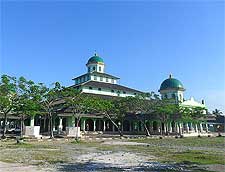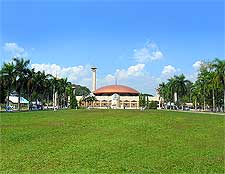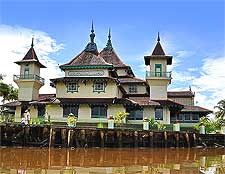Kalimantan History Facts and Timeline
(Kalimantan, Indonesia)

The Indonesian territory of Borneo, a massive island shared with Malaysia, is known as Kalimantan. Covering more than 70 percent of the island, Kalimantan has had the most influence when it comes to the shaping and development of this wild and exotic corner of the globe.
The history of the island is still largely unknown, shrouded in the murky legends of tribes like the Dayak, who have only recently been introduced to the greater realm of humanity. East Kalimantan is particularly fascinating, being the oldest of all Indonesia's Hindu kingdoms and boasting a number of ancient archaeological sites.
The Dayak and the Malay
Nearly all of the population of Kalimantan was made up of the indigenous Dayak tribes, who were the only inhabitants of this region of Borneo until the 17th century. The major tribes of the Dayak remain the key attraction for visitors, as they have largely managed to hold on to their ancient traditions.
The Malay were the first outsiders to migrate to Kalimantan, establishing their own sultanates, such as the Muslim Sultanate of Banjar in the central region. The Malay typically subjugated the Dayak people when they set up their sultanates and tried to convert them to Islam.

The Chinese Lanfang
Most of the first Malay settled in West Kalimantan, followed afterwards by a flood of Chinese miners who moved to the island to send mineral resources back to China. The Chinese created their own little state known as the Lanfang Republic, which defeated most of the local Malay sultans in the 1800s.
The Dutch Arrive
The days of the Lanfang Republic came crashing to an end in the late 1800s, when the Dutch arrived in West Kalimantan and established themselves as the new rulers. From then on, the history of Kalimantan would be shaped by the Asian and European struggle over who would control the seemingly vast resources of Borneo. All the while, the native Dayak have been caught in the middle, being pushed towards subservience and pulled towards various religious ideologies.
Japanese Occupation
During WWII, West Kalimantan fell under the control of Japanese troops. Between 1942 and 1945, more than 20,000 residents of the main city of Pontianak were kidnapped, tortured and killed by Japanese soldiers. The occupiers were worried that the ethnic Chinese of the region were planning a rebellion and were being secretly supplied with weapons by the Chinese government.
The end of WWII proved that the Chinese threat was just a farce created by Japanese officers looking for a promotion. The officers were subsequently arrested and tried by an international military court. The Makam Juang Mandor monument commemorates this tragedy.

Emergence and Autonomy of the Dayaks
After Indonesian independence was achieved, the Dayak tribes living in South Kalimantan were granted greater freedom and the province was divided into separate regions. In Central Kalimantan, the Dayak gained prominence when Tjilik Riwut was awarded the title of governor, and today, the tribes comprise the peoples of Dusun Ma'anyan Ot Siang, Ngaju and Ot Danum.
Indonesian Infighting
The modern history of Kalimantan has been mired in conflict as Indonesia and Malaysia fought for control of Borneo. Later, Indonesian infighting between President Sukarno, who was deposed by Suharto in 1965, and troops with opposing beliefs battled it out guerrilla style in the jungles of Kalimantan. The new Suharto military government fought running battles with the fighters of the banned Indonesian Communist Party for the next ten years.
Today, Kalimantan's history is still one of simmering conflict between the Indonesian government, the indigenous Dayak and the many other ethnic groups who now call Borneo home. Wild and largely lawless, this is now one of the world's last outposts for unfettered wildlife and adventure.
 The Indonesian territory of Borneo, a massive island shared with Malaysia, is known as Kalimantan. Covering more than 70 percent of the island, Kalimantan has had the most influence when it comes to the shaping and development of this wild and exotic corner of the globe.
The Indonesian territory of Borneo, a massive island shared with Malaysia, is known as Kalimantan. Covering more than 70 percent of the island, Kalimantan has had the most influence when it comes to the shaping and development of this wild and exotic corner of the globe.
